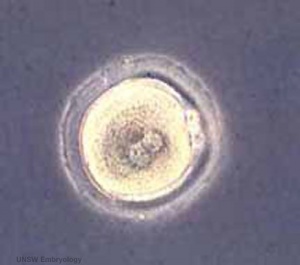Somatic Cell Nuclear Transfer: Difference between revisions
(Created page with "==Introduction== Page Under Development thumb|300px|Early Human Zygote, with 2 pronuclei The first diploid cell that forms following [[fertilization...") |
No edit summary |
||
| Line 1: | Line 1: | ||
==Introduction== | ==Introduction== | ||
Page Under Development | '''''Page Under Development''''' | ||
[[File:Early zygote.jpg|thumb|300px|Early Human Zygote, with 2 pronuclei]] | [[File:Early zygote.jpg|thumb|300px|Early Human Zygote, with 2 pronuclei]] | ||
The first diploid cell that forms following [[fertilization]] by fusion of the haploid [[oocyte]] (egg) and [[spermatozoa]] (sperm) resulting in the combination of their separate genomes. The first image shows the cell with the 2 pronuclei still present before fusion enclosed within the zona pellucida. In humans, this cell then undergoes a series of mitotic cell divisions, still enclosed within the zona pellucida, during the first few days of development to form 2 blastomeres then a solid cell mass called the [[morula]]. | The first diploid cell that forms following [[fertilization]] by fusion of the haploid [[oocyte]] (egg) and [[spermatozoa]] (sperm) resulting in the combination of their separate genomes. The first image shows the cell with the 2 pronuclei still present before fusion enclosed within the zona pellucida. In humans, this cell then undergoes a series of mitotic cell divisions, still enclosed within the zona pellucida, during the first few days of development to form 2 blastomeres then a solid cell mass called the [[morula]]. | ||
:''' | :[[Somatic Cell Nuclear Transfer|'''SCNT Links''': [[Somatic Cell Nuclear Transfer|Introduction]] | [[Stem_Cells_-_Adult#Somatic_Cell_Nuclear_Transfer|Stem Cells - SCNT]] | [[Assisted Reproductive Technology|ART]] | [[Fertilization]] | [[Week 1]] | [[Morula]] | [[Blastocyst]] | [[Assisted Reproductive Technology|ART]] | [[:Category:Zygote|Category:Zygote]] | ||
== Some Recent Findings == | == Some Recent Findings == | ||
| Line 11: | Line 12: | ||
|-bgcolor="F5FAFF" | |-bgcolor="F5FAFF" | ||
| | | | ||
* '''Number of blastomeres and distribution of microvilli in cloned mouse embryos during compaction'''<ref><pubmed>20735894</pubmed></ref> "We concluded that: (i) the cleavage of blastomeres in cloned embryos was slow at least before compaction; (ii) the distribution of microvilli in cloned, normal, parthenogenetic, and tetraploid embryos was coherent before and after compaction; and (iii) the initiation of compaction in somatic cell nuclear transfer (SCNT) embryos was delayed compared with that of intracytoplasmic sperm injection (ICSI) embryos." | * '''Number of blastomeres and distribution of microvilli in cloned mouse embryos during compaction'''<ref><pubmed>20735894</pubmed></ref> "We concluded that: (i) the cleavage of blastomeres in cloned embryos was slow at least before compaction; (ii) the distribution of microvilli in cloned, normal, parthenogenetic, and tetraploid embryos was coherent before and after compaction; and (iii) the initiation of compaction in somatic cell nuclear transfer (SCNT) embryos was delayed compared with that of intracytoplasmic sperm injection (ICSI) embryos." | ||
|} | |} | ||
[[Molecular_Development_-_Epigenetics|Epigenetics]] | |||
==References== | ==References== | ||
Revision as of 13:05, 22 August 2012
Introduction
Page Under Development
The first diploid cell that forms following fertilization by fusion of the haploid oocyte (egg) and spermatozoa (sperm) resulting in the combination of their separate genomes. The first image shows the cell with the 2 pronuclei still present before fusion enclosed within the zona pellucida. In humans, this cell then undergoes a series of mitotic cell divisions, still enclosed within the zona pellucida, during the first few days of development to form 2 blastomeres then a solid cell mass called the morula.
- [[Somatic Cell Nuclear Transfer|SCNT Links: Introduction | Stem Cells - SCNT | ART | Fertilization | Week 1 | Morula | Blastocyst | ART | Category:Zygote
Some Recent Findings
|
References
- ↑ <pubmed>20735894</pubmed>
Journals
- Zygote An international journal dedicated to the rapid publication of original research in early embryology, Zygote covers interdisciplinary studies in animals and humans, from gametogenesis through fertilization to gastrulation.
Reviews
Articles
Search Pubmed
June 2010 "zygote" All (6213) Review (651) Free Full Text (1543)
Search Pubmed: zygote
Glossary Links
- Glossary: A | B | C | D | E | F | G | H | I | J | K | L | M | N | O | P | Q | R | S | T | U | V | W | X | Y | Z | Numbers | Symbols | Term Link
Cite this page: Hill, M.A. (2024, April 18) Embryology Somatic Cell Nuclear Transfer. Retrieved from https://embryology.med.unsw.edu.au/embryology/index.php/Somatic_Cell_Nuclear_Transfer
- © Dr Mark Hill 2024, UNSW Embryology ISBN: 978 0 7334 2609 4 - UNSW CRICOS Provider Code No. 00098G
